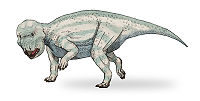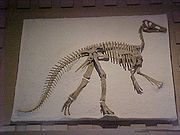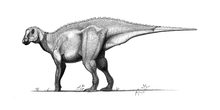
Santonian
Encyclopedia
The Santonian is an age in the geologic timescale or a chronostratigraphic
stage. It is a subdivision of the Late Cretaceous
epoch
or Upper Cretaceous series
. It spans the time between 85.8 ± 0.7 mya (million years ago) and 83.5 ± 0.7 mya. The Santonian is preceded by the Coniacian
and is followed by the Campanian
.
geologist Henri Coquand in 1857. It is named after the city of Saintes
in the region of Saintonge
, where the original type locality
is located.
The base of the Santonian stage is defined by the appearance of the inoceramid
bivalve Cladoceramus undulatoplicatus. Its top (the base of the Campanian stage) is marked by the extinction of the crinoid
Marsupites testudinarius
. In 2009, a GSSP (official reference profile) for both base and top had not yet been appointed.
the Santonian is coeval with a single ammonite
biozone
: that of Placenticeras polyopsis
. Biostratigraphy
based on inoceramids, nannoplankton or forams is more detailed.
†Pterosaur
Flora
Advanced dicotyledon
s
Chronostratigraphy
Chronostratigraphy is the branch of stratigraphy that studies the age of rock strata in relation to time.The ultimate aim of chronostratigraphy is to arrange the sequence of deposition and the time of deposition of all rocks within a geological region, and eventually, the entire geologic record of...
stage. It is a subdivision of the Late Cretaceous
Late Cretaceous
The Late Cretaceous is the younger of two epochs into which the Cretaceous period is divided in the geologic timescale. Rock strata from this epoch form the Upper Cretaceous series...
epoch
Epoch (geology)
An epoch is a subdivision of the geologic timescale based on rock layering. In order, the higher subdivisions are periods, eras and eons. We are currently living in the Holocene epoch...
or Upper Cretaceous series
Series (stratigraphy)
Series are subdivisions of rock layers made based on the age of the rock and corresponding to the dating system unit called an epoch, both being formally defined international conventions of the geological timescale. A series is therefore a sequence of rock depositions defining a...
. It spans the time between 85.8 ± 0.7 mya (million years ago) and 83.5 ± 0.7 mya. The Santonian is preceded by the Coniacian
Coniacian
The Coniacian is an age or stage in the geologic timescale. It is a subdivision of the Late Cretaceous epoch or Upper Cretaceous series and spans the time between 89.3 ± 1 Ma and 85.8 ± 0.7 Ma...
and is followed by the Campanian
Campanian
The Campanian is, in the ICS' geologic timescale, the fifth of six ages of the Late Cretaceous epoch . The Campanian spans the time from 83.5 ± 0.7 Ma to 70.6 ± 0.6 Ma ...
.
Stratigraphic definition
The Santonian stage was established by FrenchFrance
The French Republic , The French Republic , The French Republic , (commonly known as France , is a unitary semi-presidential republic in Western Europe with several overseas territories and islands located on other continents and in the Indian, Pacific, and Atlantic oceans. Metropolitan France...
geologist Henri Coquand in 1857. It is named after the city of Saintes
Saintes
Saintes is a French commune located in Poitou-Charentes, in the southwestern Charente-Maritime department of which it is a sub-prefecture. Its inhabitants are called Saintaises and Saintais....
in the region of Saintonge
Saintonge
Saintonge is a small region on the Atlantic coast of France within the département Charente-Maritime, west and south of Charente in the administrative region of Poitou-Charentes....
, where the original type locality
Type locality (geology)
Type locality , also called type area or type locale, is the where a particular rock type, stratigraphic unit, fossil or mineral species is first identified....
is located.
The base of the Santonian stage is defined by the appearance of the inoceramid
Inoceramidae
Inoceramidae was a family of prehistoric clams. Inoceramids tended to live in upper bathyal and neritic environments. In Alaska's Matanuska Formation, the most abundant mollusks in the quarry containing the Talkeetna Mountains Hadrosaur were inoceramids....
bivalve Cladoceramus undulatoplicatus. Its top (the base of the Campanian stage) is marked by the extinction of the crinoid
Crinoid
Crinoids are marine animals that make up the class Crinoidea of the echinoderms . Crinoidea comes from the Greek word krinon, "a lily", and eidos, "form". They live both in shallow water and in depths as great as 6,000 meters. Sea lilies refer to the crinoids which, in their adult form, are...
Marsupites testudinarius
Marsupites
Marsupites is an extinct genus of crinoid from the Cretaceous.-Sources:* Fossils by David Ward...
. In 2009, a GSSP (official reference profile) for both base and top had not yet been appointed.
Subdivision
The Santonian is sometimes subdivided into Lower, Middle and Upper substages. In the Tethys domainTethys Ocean
The Tethys Ocean was an ocean that existed between the continents of Gondwana and Laurasia during the Mesozoic era before the opening of the Indian Ocean.-Modern theory:...
the Santonian is coeval with a single ammonite
Ammonite
Ammonite, as a zoological or paleontological term, refers to any member of the Ammonoidea an extinct subclass within the Molluscan class Cephalopoda which are more closely related to living coleoids Ammonite, as a zoological or paleontological term, refers to any member of the Ammonoidea an extinct...
biozone
Biozone
Biostratigraphic units or Biozones are intervals of geological strata that are defined on the basis of their characteristic fossil taxa....
: that of Placenticeras polyopsis
Placenticeras
Placenticeras is an ammonite genus from the Late Cretaceous. Its fossils have been found in Asia, Europe, North and South America.-Taxonomy:...
. Biostratigraphy
Biostratigraphy
Biostratigraphy is the branch of stratigraphy which focuses on correlating and assigning relative ages of rock strata by using the fossil assemblages contained within them. Usually the aim is correlation, demonstrating that a particular horizon in one geological section represents the same period...
based on inoceramids, nannoplankton or forams is more detailed.
†Ankylosaurs
| Ankylosaurs of the Santonian | ||||
|---|---|---|---|---|
| Taxa | Presence | Location | Description | Images |
|
||||
|
Pinacosaurus Pinacosaurus is a genus of medium-sized ankylosaur dinosaurs that lived from the late Santonian to the late Campanian stages of the late Cretaceous Period , in Mongolia and China... |
||||
|
Tsagantegia Tsagantegia is a genus of medium-sized ankylosaurid dinosaur from the Upper Cretaceous Mongolia, during the Cenomanian stage.The holotype specimen , a complete skull, was recovered from the Bayan Shireh Formation , at the Tsagan-Teg locality, Dzun-Bayan, in the southeastern Gobi Desert, Mongolia... |
||||
Birds
| Birds of the Santonian | ||||
|---|---|---|---|---|
| Taxa | Presence | Location | Description | Images |
†Apatornis Apatornis Apatornis is a prehistoric terrestrial bird genus endemic to North America during the Late Cretaceous living about 83.5 mya. It is known from a single fossil specimen: a synsacrum, the fused series of vertebrae over the hips.-Taxonomy:... |
||||
†Neuquenornis Neuquenornis Neuquenornis volans was an enantiornithine bird which lived during the Late Cretaceous in today's Patagonia, Argentina. It is presently the only known species of the genus Neuquenornis. Its fossils were found in the Santonian Bajo de la Carpa Formation, dating from about 85-83 million years ago.... |
||||
†Parahesperornis Parahesperornis Parahesperornis is a prehistoric flightless bird genus from the Late Cretaceous. Its range in space and time may have been extensive, but its remains are rather few and far between, at least compared with its contemporary relatives in Hesperornis. Remains are known from central North America,... |
||||
†Patagopteryx Patagopteryx Patagopteryx is an extinct monotypic genus of birds that lived during the Late Cretaceous, around 80 mya, in what is now the Sierra Barrosa in northwestern Patagonia, Argentina. About the size of a chicken, it is the earliest known unequivocal example of secondary flightlessness: its skeleton... |
||||
Cartilaginous Fish
| Cartilaginous Fish of the Santonian | ||||
|---|---|---|---|---|
| Taxa | Presence | Location | Description | Images |
|
||||
|
|
||||
|
|
||||
†Ceratopsians
| Ceratopsians of the Santonian | ||||
|---|---|---|---|---|
| Taxa | Presence | Location | Description | Images |
|
  |
|||
|
||||
|
Udanoceratops Udanoceratops is a genus of ceratopsian dinosaur. It lived during the Late Cretaceous Period in the late Santonian or early Campanian faunal stages... |
||||
Crocodylomorphs
| Crocodylomorphs of the Santonian | ||||
|---|---|---|---|---|
| Taxa | Presence | Location | Description | Images |
|
 |
|||
|
Shamosuchus Shamosuchus is an extinct genus of neosuchian crocodile that lived during the Late Cretaceous period in what is now the Gobi desert of Mongolia, approximately 85 to 65 million years ago. The teeth were adapted to crush bivalves, gastropods and other animals with a shell or exoskeleton . The genus... |
||||
Mammals
| Mammals of the Santonian | ||||
|---|---|---|---|---|
| Taxa | Presence | Location | Description | Images |
|
||||
†Ornithopods
| Ornithopods of the Santonian | ||||
|---|---|---|---|---|
| Taxa | Presence | Location | Description | Images |
|
   |
|||
|
||||
|
Gryposaurus Gryposaurus was a genus of duckbilled dinosaur that lived about 83 to 75.5 million years ago, in the Late Cretaceous of North America... |
||||
|
Nipponosaurus Nipponosaurus is a lambeosaurine hadrosaurid from Asia.The holotype was discovered in November 1934 during the construction of a hospital for the Kawakami colliery of the Mitsui Mining Company on Karafuto Prefecture , and additional material belonging to the specimen was recovered... |
||||
†Plesiosaurs
| Plesiosauria Plesiosauria Plesiosauria is an order of Mesozoic marine reptiles. Plesiosaurs first appeared in the Early Jurassic Period and became especially common during the Jurassic Period, thriving until the K-T extinction at the end of the Cretaceous Period.The name "plesiosaur" is used to refer to the order... of the Santonian |
||||
|---|---|---|---|---|
| Taxa | Presence | Location | Description | Images |
|
Dolichorhynchops osborni from Coniacian Coniacian The Coniacian is an age or stage in the geologic timescale. It is a subdivision of the Late Cretaceous epoch or Upper Cretaceous series and spans the time between 89.3 ± 1 Ma and 85.8 ± 0.7 Ma... to Campanian Campanian The Campanian is, in the ICS' geologic timescale, the fifth of six ages of the Late Cretaceous epoch . The Campanian spans the time from 83.5 ± 0.7 Ma to 70.6 ± 0.6 Ma ... |
Fort Hays Limestone, Kansas, USA |  |
|
†PterosaurPterosaurPterosaurs were flying reptiles of the clade or order Pterosauria. They existed from the late Triassic to the end of the Cretaceous Period . Pterosaurs are the earliest vertebrates known to have evolved powered flight...
s
| Pterosaurs of the Santonian | ||||
|---|---|---|---|---|
| Taxa | Presence | Location | Description | Images |
|
 |
|||
|
Bakonydraco Bakonydraco is a genus of azhdarchid pterosaur of the Santonian-age Upper Cretaceous Csehbánya Formation of the Bakony Mountains, Iharkút, Veszprém, western Hungary.... |
||||
†Sauropods
| Sauropods Sauropoda Sauropoda , or the sauropods , are an infraorder of saurischian dinosaurs. They had long necks, long tails, small heads , and thick, pillar-like legs. They are notable for the enormous sizes attained by some species, and the group includes the largest animals to have ever lived on land... of the Santonian |
||||
|---|---|---|---|---|
| Taxa | Presence | Location | Description | Images |
|
||||
Squamates
| Squamates of the Santonian | ||||
|---|---|---|---|---|
| Taxa | Presence | Location | Description | Images |
†Eonatator Eonatator Eonatator is a genus of halisaurine mosasaur from the Upper Cretaceous of North America and Europe. Originally, this taxon was included within Halisaurus, but was placed in its own genus... |
 |
|||
|
||||
|
†Tylosaurus Tylosaurus Tylosaurus was a mosasaur, a large, predatory marine lizard closely related to modern monitor lizards and to snakes.-Paleobiology:... |
||||
†Theropods (non-avian)
| †Non-avian Paraphyly A group of taxa is said to be paraphyletic if the group consists of all the descendants of a hypothetical closest common ancestor minus one or more monophyletic groups of descendants... theropods Theropoda Theropoda is both a suborder of bipedal saurischian dinosaurs, and a clade consisting of that suborder and its descendants . Dinosaurs belonging to the suborder theropoda were primarily carnivorous, although a number of theropod groups evolved herbivory, omnivory, and insectivory... of the Santonian |
||||
|---|---|---|---|---|
| Taxa | Presence | Location | Description | Images |
†Achillesaurus Achillesaurus Achillesaurus is a genus of alvarezsaurid theropod dinosaur from the Santonian-age Upper Cretaceous Bajo de la Carpa Formation of Rio Negro, Argentina. It was a relatively large, basal alvarezsaurid, and a contemporary of Alvarezsaurus... |
||||
†Achillobator Achillobator Achillobator is a genus of dromaeosaurid theropod dinosaur from the late Cretaceous Period of what is now Mongolia, about 90 million years ago. It was probably an active bipedal predator, hunting with the large sickle-shaped claw on the second toe of each hind foot... |
||||
†Alectrosaurus Alectrosaurus Alectrosaurus is a genus of tyrannosaurid theropod dinosaur from the Late Cretaceous Period of Inner Mongolia. It was a bipedal carnivore with a body shape similar to its much larger relative, Tyrannosaurus rex... |
||||
†Aucasaurus Aucasaurus Aucasaurus was a genus of medium-sized theropod dinosaur from Argentina that lived during the Santonian stage . It was smaller than the related Carnotaurus, although more derived in some ways, such as its extremely reduced arms and almost total lack of fingers.The type skeleton is complete to the... |
||||
FloraFloraFlora is the plant life occurring in a particular region or time, generally the naturally occurring or indigenous—native plant life. The corresponding term for animals is fauna.-Etymology:...
- MagnoliopsidaMagnoliopsidaMagnoliopsida is a valid botanical name for a class of flowering plants. By definition the class will include the family Magnoliaceae, but its circumscription can otherwise vary, being more inclusive or less inclusive depending upon the classification system being discussed.-Cronquist and...
Advanced dicotyledon
Dicotyledon
The dicotyledons, also known as dicots, are a group of flowering plants whose seed typically has two embryonic leaves or cotyledons. There are around 199,350 species within this group...
s
-
- DroseraceaeDroseraceaeDroseraceae is the botanical name for a family of flowering plants. The family is also known under its common name, the sundew family.It consists of carnivorous plants: besides the sundews, the genus Drosera, it also contains the even more-famous Venus fly trap Dionaea muscipula...
: †Palaeoaldrovanda
- Droseraceae
External links
- GeoWhen Database - Santonian
- Late Cretaceous timescale, at the website of the subcommission for stratigraphic information of the ICS
- Stratigraphic chart of the Late Cretaceous, at the website of Norges Network of offshore records of geology and stratigraphy

